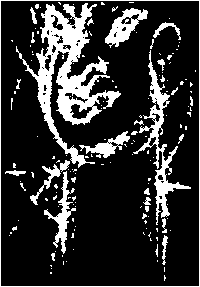Aspects of the Path
Geshe Sonam Rinchen
Ruth Sonam,
Translator
(Snow Lion)
 One time my friend Cese saw the Dalai Lama on the boardwalk at Santa Cruz. He was walking briskly, surrounded by his inscrutable guards. As she watched, the four of them went into the Fun House, the place where you get lost in the mirrors and run into plate glass trying to get the hell out.
One time my friend Cese saw the Dalai Lama on the boardwalk at Santa Cruz. He was walking briskly, surrounded by his inscrutable guards. As she watched, the four of them went into the Fun House, the place where you get lost in the mirrors and run into plate glass trying to get the hell out.
She sat there for a good half-hour, waiting for him to emerge, and --- she reports --- he never did. She figures he is probably still in there, pausing every now and again in his perambulations to meditate on America's ability to create a mirrored trap from which no one can escape.
We all love the Dalai Lama because he's such a study, him in his Reeboks, going everywhere, even into amusement parks (can you imagine any of our political or religious leaders spending time in the Fun House --- outside the U. S. Senate and House.) He's an adventurer --- asking merely that the Chinese stop being so boorish, to let him go home.
But the image the Dalai Lama gives us of Buddhism is more than a little misleading. As one of my friends wrote, "Buddhism has more hells than Dante ever dreamed of." One of the worst hells of them all is called rebirth: they are going to make you and me come back again, and again, and again to this place they call living-on-earth: to go through yet another life, and others after that --- until, finally, we get it right. I suggest that beats the Christian concept of hell to a fare-thee-well.
The Three Principal Aspects of the Path is clear, and concise and --- in its own way --- it's a hell-fire and damnation speech on the causality of our sorrow, as seen through the sharp lens of Buddhism. The "three principal aspects" in the title refer to the search for enlightenment in which:
- "There must be a strong wish for freedom," freedom, in this case, being the desire not to be reborn in this or any other world;
- This can be accomplished only through "a correct understanding of reality," (the ability to cut through false thinking and destructive living habits); and, finally,
- That enlightenment is only possible if we achieve it not for ourselves, but "for the good and happiness of all living beings."
Buddhist philosophy tells us of the difference between suffering and pain --- pain being the natural condition of human life, suffering being a resistance to pain, and clinging to the falsity which is life. Rinchen describes six different kinds of suffering:
- The uncertainty of our loves and lives;
- Our lack of satisfaction --- no matter what we do, we are always hungering for more;
- Identification with our body, "which is quite unreliable and cannot last;"
- The merry-go-round aspect of life, never stable --- always going up and down, up and down;
- Our aloneness ("when you die, you die alone"); and
- Being born again and again, "each time we have to give up our body and begin once more."
If this were but a disquisition on the three "aspects," this volume would be no more than an interesting journey. What makes it fascinating are the side trips Rinchen makes. For instance, he is capable of a mystic poetry amidst his prose: "The best kind of practitioner dies with joy. A mediocre practitioner has no fears and the least accomplished practitioner has no regrets."
Unable to obtain what we have projected, which in reality does not exist, we suffer frustration and disappointment. This easily arouses anger, which is distressing now and creates future suffering. Confusion nourishes attachment and anger and makes us cling to suffering and its causes.
There are times when Renchin's convolutions of words can but boggle the brain:
The attribution must also be unharmed by awareness investigating the ultimate. For instance, if one designated an objectively existent table to the basis of designation, this would certainly appear to conventional perception and would not be contradicted by any valid convention perception, but would be invalidated by awareness investigating the ultimate.
But these baffling statements are more than balanced by the passages that are so fired with the imaginative force of words that one can scarce forget them. This is a description of old age:
Sickness makes your skin dry and slack. You begin to lose weight and your eyes look sunken. Instead of tasty food, which disagrees with you and aggravates your condition, you have to swallow medicines which taste bitter and unpleasant. Your bedside table is laden with bottles of pills. You endure painful injections, harrowing treatments and even the most radical surgery in the hope that you will recover.
And this is a description of rebirth:
In the Occident people imagine the womb as a comfortable and pleasant place, but in the Orient, a rather different view prevails. The womb is seen as a dark and confining environment in which the fetus feeds off unclean substances like a dung-worm...Could you bear to spend even a day squeezed into a copper vat full of sewage with the lid tightly closed? Or what if you were stuffed into a barely large enough foul-smelling jute bag and then its mouth was tied?